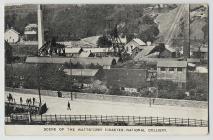Wattstown Colliery Disasters
Items in this story:
From rural to industrial
Wattstown was a fairly rural area before the beginning of the industrial age. Its name at the time was Pont Rhyd y Cwch or Pont-y-cwtch. It is situated in the Rhondda valleys and was called Cwtch locally. When the first census was taken in 1841, there were only three farms there: Aberllechau, Tŷ Gwaudd and Cefn Llechau Isha.
When the colliery opened, the area's population rose sharply, and the village was called Wattstown after Edmund Hannay Watts from Northumberland. He was the senior partner in Watts, Watts & Co., which later became the National Steam Coal Company, and The National Colliery was bought in 1884, three years after the pit had been sunk.
Between 1884 and 1885, the National Colliery Company built 60 homes in Hillside Terrace and 29 more in Bailey Street to accommodate job seekers from other parts of Wales and from England.
The 1887 Disaster
On Wednesday, 18 February 1887, there was an explosion at the coal mine, and 39 miners were killed and 6 injured. This happened between the day shift and the night shift, and this is the reason, probably, that the number of deaths was relatively low. The explosion was so powerful that the winding gear was damaged and slowed the rescue team down several hours. Once the team reached the pit, it managed to bring 38 men to the surface, 29 of them uninjured!
The official inquiry notes - “the operation of the colliery was conducted in a loose manner, that is, not as carefully as the case required. The Cause of the explosion was the result of firing a shot without proper precautions...”
The National was regarded as a modern coal mine, and after the first accident, electric lighting was installed. This was the first mine in South Wales to be lit completely by electricity.
The 1905 Disaster
There was another explosion in the National coal mine on Tuesday 11 July a 11.45am. 119 men and boys were killed this time, 56 of them under 20 years of age, and of those, 33 under 15.
This explosion was caused by gelignite which was being used to clear an area of the pit where gas had accumulated. It was against the law to use gelignite in a colliery, apart from for sinking a new shaft, as gases often accumulated. The pit manager, Mr William Meredith, had just reached the surface after having been visiting the pit. After the explosion he returned immediately, but unfortunately died of suffocation. Only three men were saved this time, and two of them later died of their injuries. Only Mathew Davies survived.
In the official report it was noted that the accident had left 44 widows and 110 children without fathers. Most of the funerals were held over three days, from Friday 14 to Sunday 16 July. Hundreds of thousands of people lined the route to the cemetery to pay their respects to the miners that died. The procession was over four miles long.
The coal mine was closed in 1968.


